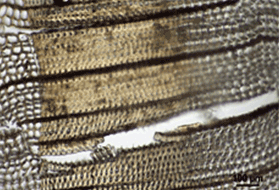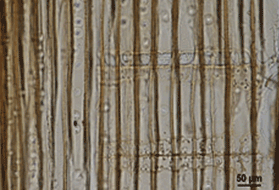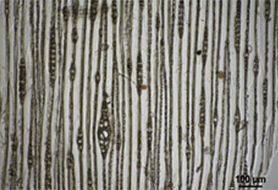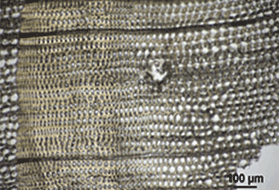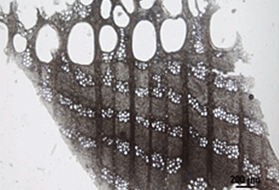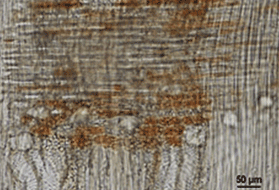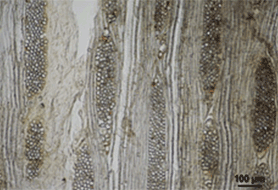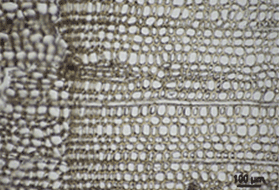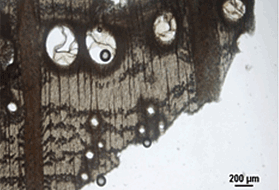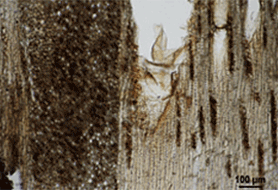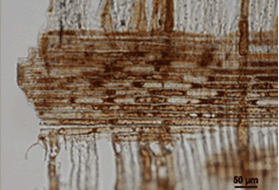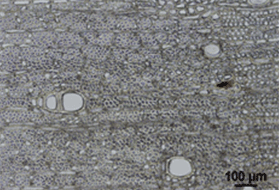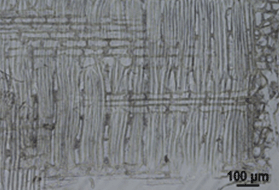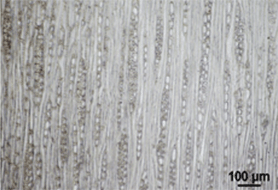Traditional
Architecture
전통건축소개
A scientific analysis of wooden elements used in traditional architecture sheds light on information they hide as well as their current condition.
First, a tree species analysis is employed to reveal the types of wood acquired and used as architectural materials.
Second, growth rings, which show unique patterns of different eras because of changes in the amount of annual growth influenced by the
climate, are compared to find out the year in which a particular tree was cut down, which can then be used to find the time of the
structure’s creation and repairs.
Third, for damaged wood, various methods are employed including perforation resistance analysis using resistography, ultrasonic wave
transmission speed measurement, and computer tomography to accurately determine the internal condition of the wood.
Fourth, AE measuring device, Termatrac and others are utilized to detect white ants that cause fatal damages to the wood.
Wood Identification
Elements replaced during repair must be new materials of the identical species of trees as the previous elements, which is why verifying the species of the existing wooden element is critical. For an accurate identification of the species, the type, size, arrangement, and pattern characteristics of cells constituting a particular wood need to be investigated to analyze the innate structural characteristics of the species.
Youngsanjeon Hall of Sucknamsa Temple (Korea Cultural Treasure No. 823)
Youngsanjeon hall has the architectural style of a Buddhist temple of the early and middle period of the Chosun Dynasty (A.D. 1392~1910). It has been designated as Korea Cultural Treasure No. 823. We have conducted research to provide basic data on the wood species in order to restore it to its original state when it was repaired in 2005. Seven species were identified, namely hard pine, exotic pine, Zelkova serrata, Ginkgo biloba, Diospyros, Quercus (Lepidobalanus) and Pyrus spp. In the case of the pillars, eight elements were hard pines and the others were Zelkova and Pyrus. Angle rafters were Ginkgo biloba and Zelkova. The two main beams were hard pine and Zelkova. The two purlins were Lepidobalanus, and rafters were pine, except for one Ginkgo and one exotic pine. Roof-filling timbers were identified as Zelkova and Diospyros spp. The other roof-filling timbers were all identified as hard pines. The use of Ginkgo and several hardwoods in addition to hard pines indicated the supply of local logs near the Sucknamsa temple.
Microscopic Feature of Woods
Hard pine; diploxylon - PINACEAE Pinus
Sula type Pinus spp. - PINACEAE Pinus
Zelkova serrata Makino - ULMACEAE
Ginkgo biloba Linn. - GINKGOACEAE
Lepidobalanus - FAGACEAE Quercus
Pyrus spp. -ROSACEAE
Diospyros spp.- EBENACEAE
Dendrochronological Dating
The principle of dendrochronological dating is that, since the growth of trees is influenced by the environment, especially climate, the trees growing in a single region share the same tree-ring width patterns uniquely generated for each era. A graph made by measuring the widths of growth rings contained in a mysterious wooden material whose era is unknown (Master Chronology) is compared against a standard chronology graph that has an already assigned absolute chronology to find out the age of the unknown wooden element. Specifically, the time of the structure’s establishment may be calculated by finding the year of the last growth ring of a sample wood that includes the tree bark, which corresponds to the year when the tree was cut down.
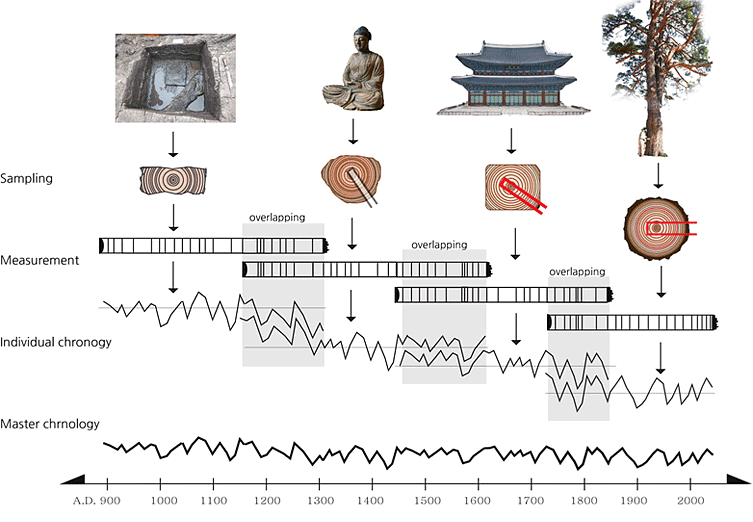
A diagram showing the process of cross-dating of live trees with dead or fossil trees allows the construction of
long-reference chronologies.
Analysis Example – Palsangjeon Wooden Pagoda of Beopjusa Temple (National Treasure No. 55)
Palsangjeon, which is a five story wooden pagoda located at Beopjusa temple, is only one wooden pagodas in Korea. According to historical records, it was reconstructed in either A.D. 1604 or A.D. 1626. To verify the reconstruction year we fulfilled tree-ring analysis. 41 wooden materials, i.e. 34 red pines (Pinus densiflora S. et Z.) and 7 oaks (Lepidobalanus), collected during repair in 2013 were mounted and sanded to make clear tree-ring boundary for measurement under a stereo microscope. All individual tree-ring series were compared with each other and also compared with a master chronology. By comparison with a mater chronology, oaks were felled in A.D. 1624 and red pines in A.D. 1624 and A.D. 1851. Based on the results we concluded Palangjeon was reconstructed in A.D. 1626 and it was repaired in A.D. 1851 using red pines.
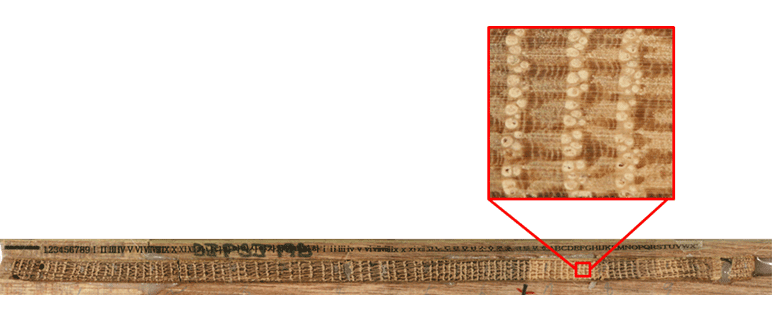
Oak(Quercuss spp., Prunus section) sample's surface clear with sanded the cores and polished
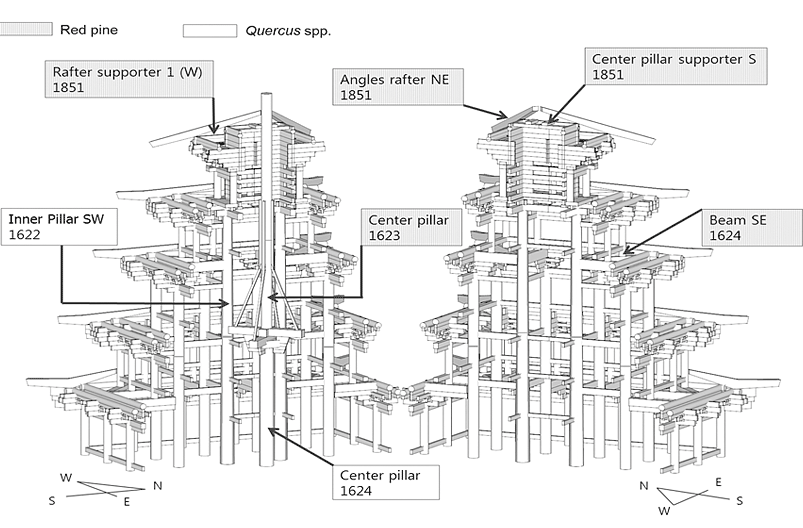
- Red pine
-
- Rafter supporter 1(W) 1851
- Angles rafter (NE) 1851
- Center pillar supporter (S) 1851
- Center pillar 1623
- Beam (SE) 1624
- Quercus spp
-
- Inner Pillar (SW) 1622
- Center pillar 1624
3D-representation of the Palsangjeon Wooden Pagoda with the felling dates of the wooden elements







 Home
Home

